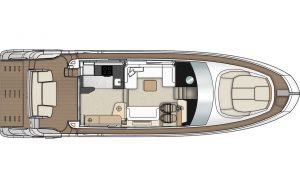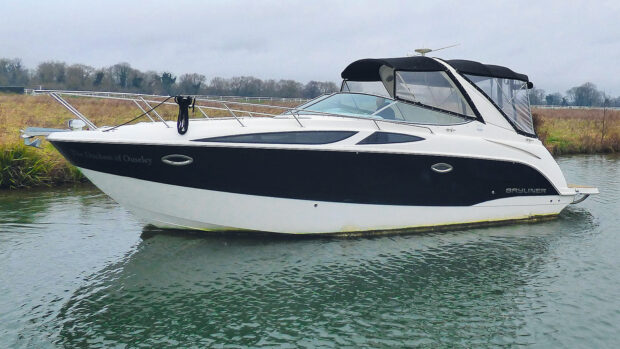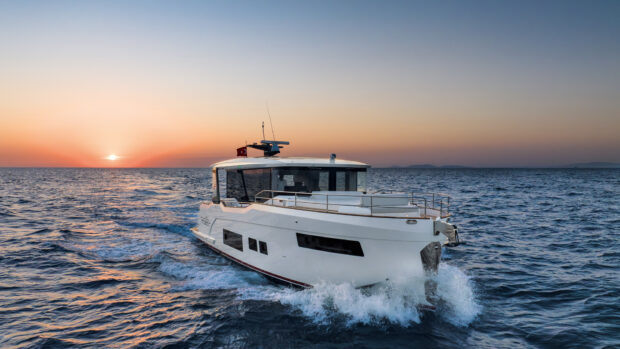The Azimut 55 has an interior to die for but is that enough to topple such a talented crop of competing boats?
From the outside it is not immediately apparent how different the Azimut 55 is from the 54 it replaces. The trace of the profile is much the same, as is the window architecture, and the dimensions are almost identical, but with the likes of the Princess 55 and Prestige 520 nipping at its bathing platform, the Italians knew they had to do something to give the 55 an edge.
Ironically, that ‘edge’ is the curvaceous interior designed by Achille Salvagni, a man who originally penned interiors for Azimut’s larger boats but has more recently been let loose on the 60 and now this, his smallest Azimut yet.
If anything, the effect is even greater on a smaller boat, as it’s such a treat to find the intricate detailing and obsessive commitment to curvature on a mid-range craft.

The elegant saloon runs with the curved theme
The talk of curves may seem like overkill but on a Salvagni interior this is no hyperbole; even the curves have curves. Cabinetry, grab handles and sofa bases – everything culminates in a soft radius, which is both aesthetically pleasing and preferable to hard corners that you might knock yourself on at sea.
It’s well finished, too, with a feeling of no-expense spared that is superior to the more affordable Prestige 520 and on a par with the Sunseeker Manhattan 52, but possibly not quite at the lofty heights of Princess and Absolute.

Azimut 78 first look: Designer yacht has curves in all the right places

Boat test: Azimut Atlantis 51
The flagship of the Azimut Atlantis range is a throwback to how sportscruisers used to be, but can it still
This, though, is an interior that grabs your attention the moment you set foot inside the yacht’s saloon, thanks to its audacious mix of colours, materials and an eye for artistic flourishes rarely seen on a boat of this size and price.
There is a brave mix of dark and light woodwork and recessed bronze-leaf highlights that gives the impression the cabinets and counter tops are floating. And the bold pastel upholstery fabric really pops against the monochrome palette of the lower dashboard and helm seats.

The dashboard is stylish but falls short on places to store loose items
Seemingly small details like the table lamps are stylish and creative, no detail is permitted to be bland or uninteresting. Crucially, there are very few instances where substance surrenders to style.
The Princess 55 and Sunseeker Manhattan 52 use glass more intelligently and therefore their interiors feel bigger but the Azimut’s main deck layout is beyond reproach.

Achille Salvagni’s flourishes make for a sumptuous interior
The most important change over the 54 – apart from the far more contemporary finish – is the switch of galley location from amidships to its new spot next to the cockpit doors.
With a neat curved return (naturally), the galley is well placed to serve both internal and external deck spaces and the raised dinette amidships with settee opposite is sociably arranged and in the best position to drink in the elevated views. The stylish furniture does come at a bit of cost, though, as there is no under-seat storage within any of the sofa units.

The striking mix of dark and light woods makes a statement
Ample accommodation
Below decks the layout and décor are no less intriguing, especially in the master cabin, which has an angled island berth and a host of delightful styling cues that are more reminiscent of an upmarket hotel suite than a boat’s cabin. Again, the texture and colour choices are rich and varied and the lamps are statement pieces in themselves.
A pair of chrome spotlights sprout from the ceiling to provide bright beams for reading in bed and there’s a signature Salvagni chest of drawers dominating the space to port. This can be replaced with a vanity station if preferred.

The master cabin calls to mind an upmarket hotel suite
The angle of the bed aligns its occupants with the port hull window but it also leaves space for a generous walk-in wardrobe aft with the ensuite bathroom tucked neatly to port adjacent to the cabin entrance.
Headroom is good all round but there are a fair few steps and levels to negotiate that could catch you out in the dark.

There are eye-catching details everywhere, including the bathrooms
Despite reworking the deck moulding to broaden the foredeck, the VIP cabin in the bow feels pinched and it wouldn’t be that comfortable if two adults were getting changed at the same time – not an unlikely scenario – as there isn’t a huge amount of space at the end of the bed.

Space is tight in the VIP cabin
The ensuite bathroom is a good size, though, and there are design notes that faithfully echo what is going on in the saloon – another nice aesthetic touch.
This bathroom also has day head access from the main lobby and is shared with those using the twin guest cabin on the starboard side.

The VIP ensuite is shared with…

…the compact but well-appointed twin cabin
Out on deck
The changes on deck over the 54 are slightly less drastic. The layout is much the same, though the space on the flybridge has been used to greater effect. Most notably aft, where, as an option, it is possible to have fixed furniture in a handful of different configurations. The pair of low-slung L-shaped sofas facing each other across a coffee table seems the best use of the space to me.
It’s a shame the same level of thought hasn’t gone into the design of the foredeck, which is essentially a fixed sunpad with adjustable headrests. Most rivals include either a walk-through section or table option up front or, in some cases, both, so the 55 is lagging behind in this respect.

There is a nice foredeck sunpad but no seating or walkway
Do things improve at the helm stations? Well it’s a mixed bag. Both look great but it doesn’t take long to unearth flaws like the MFD screens being too far away from the helm seat and an over dependence on shiny materials that look good but produce a lot of glare and get filthy with fingerprints. Both could do with more secure storage areas for loose items, too.

Helm stations are easy on the eye but lack storage
The driving experience is similarly frustrating. The 800hp MAN i6 diesels on V-drives provide ample shove and remain smooth and quiet through to full revs.
At 1,800rpm they are barely breaking a sweat yet the boat runs just shy of 20 knots, consuming around 180lph and with noise levels at only 70 dB(A). If you are in no hurry this is a blissful cruising speed.

The Azimut 55 has a cruising speed of 19 knots
What’s not so good is the handling, specifically the steering. Granted, this was an early hull and engineers were still tweaking the electric steering system, but it just felt lifeless.
The enormous steering wheel isn’t all that conducive to quick changes of direction anyway, but the rudders felt so dulled by the electronic governor that much of the driving entertainment was sucked away.

The engine room is free from unnecessary clutter
Some will point out that this doesn’t matter on a 55ft flybridge cruiser that will spend most of its life running in straight lines, and that’s fair enough, but I would urge them to get behind the wheel of a Princess 55 or an Absolute 52 Fly and stand by that opinion.
Hopefully, by now the engineers will have made some adjustments to the steering to make it faster and more responsive, but we can only go off the experience we had on our short sea trial.

The Azimut 55 is a big step up from its predecessor
It’s a small issue but a frustrating one because there is a lot to admire about the design of the 55. It sensibly uses the 54’s underpinnings but feels like an entirely different boat and that is mainly down to its knockout interior.
There is work to be done on improving the driving experience, but as a place to live, the Azimut 55 is outstanding.
Specifications
Top speed: 30.5 knots
Cruising speed: 19.3 knots
Fuel consumption: 179lph
Range: 220 miles
Noise: 70Db(A)
Price from: €1,100,000

LOA: 55ft 5in (16.9m)
Beam: 16ft 1in (4.9m)
Draught: 4ft 11in (1.5m)
Displacement: 29 tonnes
Fuel capacity: 2,560 litres
Water capacity: 590 litres
Test engines: Twin 800hp MAN i6
RCD: B for 12 people
Designer: Stefano Righini & Achille Salvagni
Price as reviewed:
£1,100,000.00












